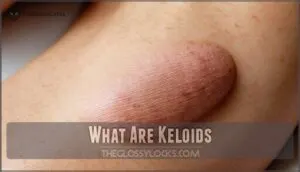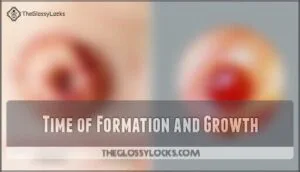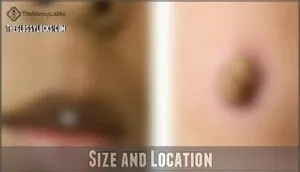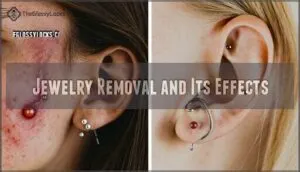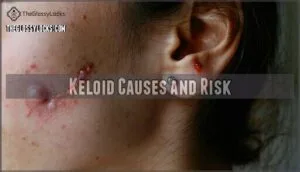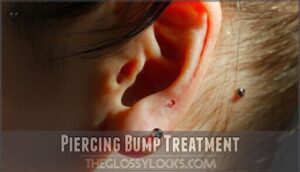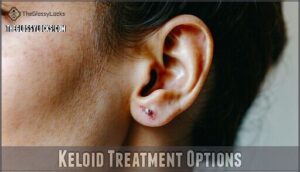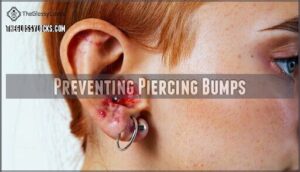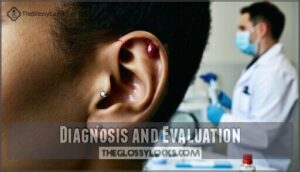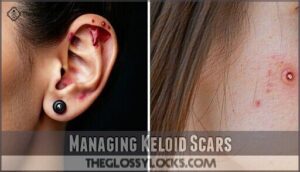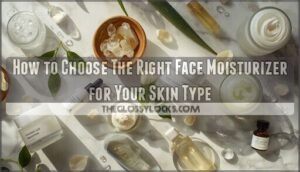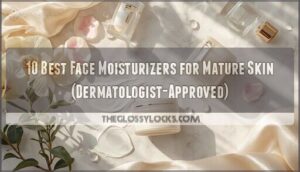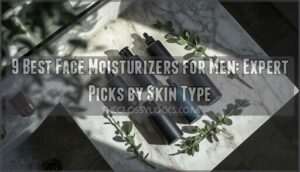This site is supported by our readers. We may earn a commission, at no cost to you, if you purchase through links.
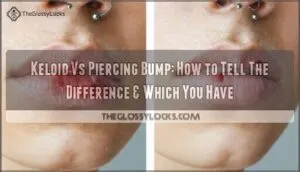
Here’s the scoop: keloids are like party crashers—they spill out beyond the piercing, get firm, and just won’t quit growing.
Piercing bumps, though, stay small and usually vanish with a bit of TLC, like sea salt soaks or gentle aftercare.
Both can be a nuisance, but keloids often run in families and need a doctor’s touch.
Think of “keloid vs piercing bump” as figuring out if you’re fighting a fire or just snuffing out a candle—big difference! Curious?
Table Of Contents
- Key Takeaways
- What Are Piercing Bumps
- What Are Keloids
- Piercing Bump Vs Keloid
- Keloid Causes and Risk
- Piercing Bump Treatment
- Keloid Treatment Options
- Preventing Piercing Bumps
- Identifying Keloids and Bumps
- Managing Keloid Scars
- Frequently Asked Questions (FAQs)
- How do I know if I have a keloid or piercing bump?
- How long does it take for a piercing bump to turn into a keloid?
- How do you flatten a piercing bump?
- Are piercing keloids hard or soft?
- How to tell if it’s a keloid or piercing bump?
- Do piercing keloids go away?
- How do I get rid of a piercing bump?
- Should you take your piercing out if you get a keloid?
- Can keloids or piercing bumps be a sign of infection?
- Are keloids and piercing bumps contagious to others somehow?
- Conclusion
Key Takeaways
- You can spot a piercing bump if it stays small, soft, and close to the piercing, while a keloid grows bigger, feels firm, and spreads beyond the original spot.
- Don’t remove your jewelry if you see a bump—keep it in and follow gentle aftercare, but see a dermatologist if it grows or gets firm.
- Piercing bumps often show up fast and fade with simple saline care, but keloids develop slowly and usually stick around without medical help.
- Your genes and how your body heals play a big role in keloid risk, so track family history and be extra cautious with aftercare if you’re prone to scarring.
What Are Piercing Bumps
If you’ve noticed a small, red bump near your piercing, you’re not alone—these bumps are a common response as your skin heals and adapts.
Your skin’s just working its magic—tiny bumps mean the healing adventure is underway.
Think of them as your body’s way of saying, "I’m working on it," though they can be just as stubborn as your favorite pair of jeans after laundry day, which can be quite stubborn.
Characteristics and Symptoms
Anyone with a new piercing might notice a tiny, pink bump forming in the first month—a classic sign of the healing process at work.
For easy symptom comparison, watch for:
- Soft, movable bump at the piercing site.
- Pink or red color, sometimes itchy.
- Flat or slightly raised, remaining local.
Piercing bump treatment is often simple; keloid removal’s another ballgame. Understanding hair removal methods can also help prevent related skin issues, especially to avoid a piercing bump.
Causes and Risk Factors
After noticing those first symptoms, it’s helpful to look at what’s causing your piercing bump.
Most often, you’ll find skin trauma, a lively immune response, or even infection risk at play.
If your family jokes about their wild scar tissue or someone whispers “genetic factors” at every bruise, genetic predisposition may put you at greater risk, too.
| Cause | Description |
|---|---|
| Skin Trauma | Injury to site |
| Infection Risk | Bacteria exposure |
| Immune Response | Body’s defense |
| Genetic Factors | Family history |
Treatment and Management
A little patience, precise wound care, and a dash of good aftercare tips make all the difference.
Here’s what you should do:
- Keep jewelry in for six weeks—no sneaky removals.
- Clean gently with saline solution.
- Pat dry; don’t scrub!
- Avoid harsh products like alcohol.
Consider Laser Therapy for persistent cases—sometimes bumps are stubborn!
What Are Keloids
You might notice keloids as thick, raised scars that keep growing beyond the original injury, looking like your skin’s attempt at modern art.
A keloid is your skin’s bold statement piece, turning a simple scar into a dramatic, never-ending story.
They’re a bit dramatic, often larger and firmer than you’d expect, but they’re simply your body’s way of overdoing the healing process, which can result in keloids.
Definition and Appearance
Keloids stand out among scar types for their large, raised, and shiny look—often darker than your surrounding skin.
Unlike a piercing bump that keeps to the pierced area, a keloid scar sprawls beyond, sometimes resembling a small mountain range.
You might compare them like this:
| Piercing Bump | Keloid Scar |
|---|---|
| Localized swelling | Wide, raised area |
| Soft, pink/red | Firm, shiny, dark |
A keloid scar is distinct due to its wide, raised area and firm, shiny, dark appearance, setting it apart from other scar types.
Symptoms and Warning Signs
If you suddenly feel itchy reactions or spot redness signs near your piercing, that’s a keloid symptom waving a little red flag.
Watch for swelling causes and firm, shiny bumps that grow slowly, often beyond the pierced area.
Unlike a piercing bump, keloids rarely calm down on their own.
Seeking bump treatment quickly helps reduce infection risks and serious scarring types.
Piercing Bump Vs Keloid
You might look in the mirror and wonder if that pesky bump is a harmless piercing reaction or a stubborn keloid trying to take over.
Let’s clear up the confusion, so you’ll know if you’re facing a fleeting irritation or a scar that likes to overstay its welcome.
Time of Formation and Growth
Watching your skin’s healing time can reveal a lot.
Piercing bumps appear fast—think days to weeks—while keloids take the scenic route, showing up months after your initial piercing. If a bump doesn’t outgrow its home, it’s likely a piercing bump.
Growth patterns differ, so track scar development for clues. Understanding piercing bump care is essential for proper healing.
Here’s a useful comparison:
| Feature | Piercing Bump Onset | Keloid Formation |
|---|---|---|
| Appearance Time | Days to weeks | 3-12 months |
| Growth Pattern | Quick then stable | Slow, progressive |
| Scar Development | Stays at piercing site | Grows beyond wound |
| Healing Time | Resolves in months | May persist or worsen |
| Tissue Regeneration | Typical | Excessive |
This information helps to differentiate between piercing bumps and keloids, allowing for more effective treatment and care.
Size and Location
After noticing when each bump or keloid appeared, you’ll want to focus on size and location.
Piercing bump size typically stays small and sticks right by the piercing hole, while keloid growth tends to sprawl, sometimes far from the original wound location.
Here’s a glance at how these features stack up:
| Feature | Piercing Bump | Keloid |
|---|---|---|
| Bump Formation | Quick, small, local | Slow, large, spreading |
| Location | At piercing site | Beyond wound area |
| Scar Tissue | Minimal | Excessive, thick |
The key differences between piercing bumps and keloids lie in their formation, location, and the amount of scar tissue they produce, with keloids often resulting in excessive tissue growth.
Jewelry Removal and Its Effects
If you’re weighing piercing bump vs keloid, think carefully before Jewelry Removal.
Removing piercing jewelry too soon can slow healing time, bump up the infection rate, or even boost your scarring risk—especially with keloid-prone skin.
For bump removal or keloid removal, follow aftercare tips, keep it clean, and listen to your piercer’s advice.
| Action | Healing Time | Scarring Risk |
|---|---|---|
| Keep Jewelry In | Faster | Lower |
| Jewelry Removal Early | Slower | Higher |
| Medicated Aftercare | Balanced | Reduced |
| Ignore Aftercare Tips | Longest | Greatest |
Keloid Causes and Risk
You might be surprised to learn your genes, skin injuries, and how your body heals play the biggest roles in whether a keloid forms.
If your family has a history of these stubborn scars, you’re more likely to join the club—sometimes all it takes is a small cut or piercing.
Genetic Predisposition
Spotting the difference between a piercing bump and a keloid? Sometimes, your genes get the final say.
Family history and genetic factors raise your keloid risk, especially if you’ve got darker skin or relatives with keloids. Ethnicity risk and hereditary traits make some skin types more prone to excess scarring, while piercing bumps rarely follow a family tree.
Understanding keloid formation risks is essential in determining the best course of action for your specific situation.
Skin Trauma and Injury
Every skin trauma—no matter how small—kicks off your body’s wound healing parade.
Got a new piercing? Even picking at a zit can spark scar tissue drama.
Here’s what elevates your risk:
- Poor trauma care stalls healthy skin regeneration.
- Inadequate piercing aftercare increases piercing bump chances.
- Minor injuries sometimes trigger a wild, keloid scar response.
Handle your healing gently!
Abnormal Healing Response
Something in your body’s healing process sometimes goes a little rogue—think of it as a well-meaning friend who just can’t stop helping.
When inflammation response goes overboard, you end up with excess scar tissue.
Abnormal healing causes keloid scars or piercing bumps, so diligent wound care and monitoring early keloid symptoms can help you avoid an unwanted souvenir.
Piercing Bump Treatment
You can treat piercing bumps with targeted measures like saline soaks, proper jewelry care, and corticosteroid injections if needed.
Don’t worry if your bump isn’t disappearing right away—while your piercing mightn’t win a beauty contest, the right treatment can help restore your skin’s smoothness.
Sea Salt Soaks and Saline Solution
If you’re stressing over keloids, don’t overlook Salt Water Therapy for piercing bump care.
Sea salt soaks have centuries-old Healing Properties.
Here’s your playbook:
- Mix a gentle saline solution—think less ocean, more soup.
- Soak twice a day.
- Pat dry—don’t rub!
- Enjoy Saline Benefits, like improved Wound Cleaning and faster recovery.
Understanding the proper sea salt uses is essential for effective treatment.
Jewelry Removal and Aftercare
While sea salt soaks lay the foundation, jewelry removal can actually backfire.
Take your time—don’t yank jewelry out just because you spot a piercing bump or keloid.
Keep it in until healed to prevent trapping infection or slowing the healing process.
Focus on wound cleaning, jewelry care, and daily aftercare tips.
Smart piercing care means better scar prevention down the road.
Corticosteroid Injections
For stubborn bumps, corticosteroid injections might be your golden ticket.
Here’s how injection therapy tackles piercing bumps and keloids:
- Cortisone treatment shrinks raised scars.
- Injections lower inflammation and collagen overgrowth.
- Sessions happen every 4–6 weeks.
- Expect scar reduction and faster healing.
- Steroid effects may include temporary skin thinning or lightening.
Always consult a specialist for scar treatment.
Keloid Treatment Options
If you’re facing a keloid, don’t worry—you’ve got several evidence-based treatment options, from cortisone injections to precise laser therapies.
Managing keloids can feel a bit like herding stubborn cats, but a dermatologist can help you choose the right solution for your skin.
Cortisone Injections
Let’s say your piercing bump doesn’t back down—cortisone injections might step up.
They tame keloids by shrinking scar tissue with corticosteroids, often improving appearance and comfort.
Expect noticeable treatment outcomes, but remember: injection risks include skin thinning or color changes.
Cortisone effects aren’t instant, but the steroid benefits are worth a shot when over-the-counter strategies aren’t working.
Silicone Gel or Sheets
If cortisone injections sound intimidating, you’re not alone—silicone gel or sheets are a gentler option that works quietly over time.
Applying silicone sheets or gel therapy directly on scar tissue encourages skin regeneration and helps flatten a keloid or piercing bump.
Think of it as Scar Reduction on autopilot, supporting wound healing and sheet application while you go about your day.
This process can be compared to using non toxic treatments for hair, which prioritize gentle and safe methods to achieve desired results, similar to a non toxic approach for overall well-being.
Laser Removal and Debulking Surgeries
Three main strategies tackle keloids: laser therapy, debulking methods, and scar revision.
Laser removal is less invasive and ideal for smaller scars, but keloids may bounce back without follow-up care.
Debulking surgeries flatten larger keloids but carry surgery risks and longer recovery tips.
Pairing laser therapy with other treatments helps keep scar reduction on track and yields better outcomes.
Preventing Piercing Bumps
You want your piercing to heal smoothly, but pesky bumps can show up if you don’t follow expert advice and a bit of common sense.
Don’t worry—making smart jewelry choices and sticking to basic hygiene really can keep those annoying bumps at bay, even if you sometimes forget where you left your phone, with common sense.
Choosing The Right Jewelry
Choosing the right jewelry material is half the battle in avoiding a piercing bump or keloid.
For most piercing types, opt for hypoallergenic metals like implant-grade titanium or niobium. Check jewelry size—too tight or loose invites trouble.
If you have a nickel allergy, steer clear of surgical steel. Aftercare tips also include sticking with smooth, well-made jewelry.
Using high-quality titanium jewelry options can substantially reduce the risk of an adverse reaction.
Avoiding Trauma and Poor Aftercare
Every piercing journey’s like a tightrope walk—wobble a little and you risk a piercing bump or even a keloid scar.
Stay steady with practical aftercare tips:
- Avoid tugging or hitting your piercing
- Clean hands before touching
- Change pillowcases frequently
- Keep hair and hats away
- Use gentle, proven Healing Strategies
Wound Care and Scar Prevention matter!
Proper Piercing Aftercare and Hygiene
Think of good Piercing Hygiene as your new hobby—after all, nobody wants to nurse a crusty piercing bump.
Stick to Aftercare Tips: cleanse gently with saline, handle jewelry with clean hands, and steer clear of alcohol-based products.
Prioritize Wound Cleaning twice daily. Diligent Jewelry Care supports the Healing Process, helping you prevent infection, keloid formation, and any piercing aftercare headaches.
Identifying Keloids and Bumps
You might notice your piercing spot looks different, but don’t panic—distinguishing a harmless bump from a keloid just takes a sharp eye and a bit of patience.
Let’s untangle the clues together, so you won’t mistake a stubborn bump for a rebellious keloid trying to steal the spotlight.
Diagnosis and Evaluation
Before blaming that bump on bad luck, use a sharp eye for Symptom Assessment. Clinical diagnosis means looking close—literally!
Here’s your playbook:
- Physical Medical Examination for size, color, and texture.
- Skin Analysis for scar patterns.
- Diagnostic Tests like biopsy (for rare cases).
- Risk Evaluation: consider your history.
- Track timing—keloids grow slowly, piercing bumps pop up fast!
This process involves careful consideration of each step to ensure an accurate diagnosis, using tools like Diagnostic Tests to inform your decision.
Consulting a Dermatologist
Sometimes, the best way to end sleepless nights over a stubborn keloid or piercing bump is a Dermatologist Visit. A professional can offer a proper Skin Exam and craft targeted Treatment Plans.
Don’t DIY your health—get Medical Advice, check Insurance Coverage, and let the dermatologist handle piercing complications with precision and care.
| Step | Benefit |
|---|---|
| Skin Exam | Accurate Diagnosis |
| Treatment Plans | Personalized Interventions |
| Insurance Coverage | Reduced Out-of-pocket |
Managing Keloid Scars
Managing keloid scars isn’t about waving a magic wand, but you’ve got plenty of proven options to help flatten and fade these stubborn marks.
With guidance from medical professionals and a dash of patience, you can take steps that really make a difference—even if your keloid’s just as stubborn as your favorite pet, and find effective ways to manage it.
Home Remedies and Self-Care
Spotting a rise or itch near your piercing? You’re not alone.
Keloid care often starts at home with careful aftercare tips.
Try a gentle saline soak twice daily—think spa day for your skin.
Some swear by diluted tea tree oil for scar treatment, though results vary.
These healing methods and natural remedies boost piercing bump home care and prevention.
Maintaining proper wound care involves understanding saline solution benefits, including its use in saline wound treatment, which is a key part of proper wound care.
Medical Treatment and Intervention
If keloids are running your life, there’s hope in clinical care.
Here’s a smart toolkit for medical intervention:
- Corticosteroid shots reduce inflammation and shrink thick scars.
- Laser therapy flattens and fades keloids, though it’s not magic.
- Keloid surgery or piercing bump removal can help but needs careful wound care.
- Silicone gel: Scar management’s old reliable.
Effective acne treatment that minimizes scarring often involves acne scar prevention methods to reduce inflammation.
Reducing Keloid Scarring and Appearance
If you’re looking to prevent keloid scars or soften their look, silicone gel sheeting deserves a gold star in Scar Prevention.
Start early, wear it for months, and don’t skip your sunscreen—sunlight loves to darken scar tissue.
For stubborn spots, ask about corticosteroid injections or laser therapy.
Remember, gentle wound healing beats rash cosmetic repair every time.
Frequently Asked Questions (FAQs)
How do I know if I have a keloid or piercing bump?
If your bump quickly appears, stays small, and hugs the piercing, it’s likely a piercing bump.
Grows slowly, gets larger than the wound, and feels firm? That’s your classic keloid marching past its borders—definitely time for expert advice!
How long does it take for a piercing bump to turn into a keloid?
A piercing bump usually won’t morph into a keloid overnight—or ever.
Keloids tend to develop months after the original injury, so if you see a bump early on, odds are it’s not becoming a keloid.
How do you flatten a piercing bump?
Did you know nearly 80% of new piercings develop some form of bump?
Keep it simple: cleanse daily with saline, avoid fiddling, and pat dry.
Most fade within weeks, like a stubborn guest finally heading home.
Are piercing keloids hard or soft?
You’ll notice keloids tend to be firm, raised, and sometimes feel rubbery—picture them like tiny, stubborn mountains on your skin’s landscape.
They’re not soft to the touch, unlike piercing bumps, which are usually much softer, and this distinction can help identify a keloid.
How to tell if it’s a keloid or piercing bump?
If that red lump sticks close to your piercing and feels soft, it’s probably just a bump.
But if it grows bigger, feels firm, and spreads beyond, you might’ve a keloid trying to steal the spotlight.
Do piercing keloids go away?
Like stubborn weeds, keloids rarely vanish on their own—you’ll need to see a dermatologist if you want results.
Medical treatments such as steroid injections or laser therapy help shrink, but don’t expect them to disappear completely, which is why seeing a dermatologist is necessary for effective treatment.
How do I get rid of a piercing bump?
Clean the piercing gently with saline, keep your hands off, and swap tea tree oil for a little extra TLC.
Skip harsh cleaners or fiddling—think of it as a grumpy guest that’ll leave with patience.
Should you take your piercing out if you get a keloid?
Don’t yank that jewelry out if you spot a keloid—removing it can actually make things worse.
Keep it in place and see a dermatologist. They’ll steer you toward proper treatment and help calm the storm.
Can keloids or piercing bumps be a sign of infection?
Bumpy business isn’t always bad—piercing bumps or keloids rarely mean infection.
If you see swelling, redness, pain, or pus, though, it’s time to worry.
Trust your gut—seek help if the bump oozes or grows.
Are keloids and piercing bumps contagious to others somehow?
You can’t pass keloids or piercing bumps to anyone else—there’s no germ involved.
It’s just your body’s unique way of healing, not a souvenir you can share, even if you’d rather return it!
Conclusion
Worried you’re reading too much into a simple bump? It’s natural—mistaking a piercing bump for a keloid, or vice versa, happens often.
By understanding “keloid vs piercing bump”, you arm yourself with knowledge, helping you spot warning signs early.
Don’t hesitate to consult a professional for anything persistent or unusual. Acting quickly can spare you stress, prevent complications, and lead you toward the right treatment for faster healing and scar reduction.
- https://drshehlaebrahim.com/piercing-bump-vs-keloid/
- https://www.thekeloidplasticsurgerycenter.com/blog/whats-the-difference-between-a-keloid-and-a-piercing-bump/
- https://www.creedmoorskinsurgerycenter.com/conditions/keloids
- https://www.lynnloheide.com/post/a-comprehensive-guide-to-piercing-bumps
- https://www.sciencedirect.com/science/article/abs/pii/S1748681522006490

